




v K I T C H E N & B AT H
v F U L L S E R V I C E D E S I G N
v C U S T O M H O M E S
R E

I



















v K I T C H E N & B AT H
v F U L L S E R V I C E D E S I G N
v C U S T O M H O M E S
R E

I














When I was in my 20s, my camping buddy Chris was always searching for that out-of-the-way spot that no one else knew about, far from cities, cars and people — the more remote the better.
Getting ready for one of our group’s outdoor adventures was a production — and packing the giant Igloo cooler was an art, which Chris had mastered. He wanted every detail to be perfect, including the spot where we’d set up camp.
I thought of my old friend last summer, when I visited Joyce Kilmer Memorial Forest in Graham County. Located in the westernmost part of the state — practically in Tennessee — it felt wild and unspoiled compared to the well-traveled trails around Blowing Rock, Boone or Asheville. I passed a whopping zero cars on the road to the parking lot, which twisted and turned and offered jaw-dropping glimpses of the gleaming Lake Santeetlah. The lake was created nearly a century ago, when industrial giant Alcoa built more than a dozen dams in the area to generate power for making aluminum. In 1939, the Forest Service bought the land and, today,
“There is a garden in every childhood, an enchanted place, where colors are brighter, the air is softer, and the morning more fragrant than ever again.”
— Elizabeth Lawrence



about 80% of the lake’s shoreline remains undeveloped. Chris would have loved it.
Traveling alone, and with my primitivecamping days long behind me, I felt slightly uneasy being in a place so far removed from civilization. At the same time, I was thrilled that such an untouched place still exists here in our great state of North Carolina.
Summer is time for exploring — discovering new places and revisiting familiar favorites (page 91). Cheers to hitting the open road, and to new adventures. SP

CATHY MARTIN EDITOR editor@southparkmagazine.com

1–Elizabeth Lawrence House & Garden in Myers Park (page 78)
2–Cornmeal ricotta cake with lavender-lemon semifreddo and blueberry coulis at Mazi (page 32)
3–Style at Any Age: Men’s edition (page 64)
4–Lake Santeetlah (page 91)
5–A Heydon Hall kitchen designed by Jacy
Kelly (page 72)

64 | Style at any age styling by Whitley Adkins photographs by Olly Yung
Charlotte men transcend trends with smart, sophisticated style.
72 | Third time’s a charm by Catherine Ruth Kelly photographs by MB Productions
A new-to-Charotte homeowner updates her Heydon Hall home with an ultramodern vibe.
78 | Sense of wonder by Jay Sifford photographs by Dustin and Susie Peck
Elizabeth Lawrence found magic in each new leaf and flower in her Myers Park garden.

BLVD.
20 | style
Longtime friends launch Sitano to fill a gap in the resortwear business.
24 | interiors
The wild side: Louise Hane creates a two-room sanctuary in Highlands.
28 | arts
SOCO Gallery celebrates 10 years of amplifying local talent — and attracting museum-quality artists to Charlotte.
32 | cuisine
First look: Mazi showcases bold flavors with southern soul.
40 | around town
What’s new and coming soon in the Queen City
42 | happenings
June calendar of events
86| Funny business by Page Leggett
Charlotte Squawks has been delighting crowds — and occasionally offending the thin-skinned — for 20 years.
91 | Explore the Carolinas by Ross Howell Jr., Vanessa Infanzon, Cathy Martin and Sharon Smith
Summer means road trips, checking out new (or time-tested) places and clocking out early for long weekends away. Pick a destination that suits your mood, from a chic urban escape in Charleston to a kiteboarding adventure in the Outer Banks.
47 | art of the state
Belmont artist Juan Logan keeps creating
53| bookshelf
June’s new releases
55 | simple life
The gift of nature, and the power of the Earth to heal
59| givers
Ace The Stigma supports children and adults suffering from mental illness.
101 | swirl
Parties, fundraisers and events around Charlotte
104 | in plain view
Spiral Odyssey: More than meets the eye





1230 West Morehead St., Suite 308 Charlotte, NC 28208
704-523-6987 southparkmagazine.com
Ben Kinney Publisher publisher@southparkmagazine.com
Cathy Martin Editor cathy@southparkmagazine.com
Sharon Smith Assistant Editor sharon@southparkmagazine.com
Andie Rose Creative Director
Alyssa Kennedy Art Director alyssamagazines@gmail.com
Whitley Adkins Style Editor
Contributing Editors
David Mildenberg, Michael J. Solender
Contributing Writers
Michelle Boudin, Jim Dodson, Ross Howell Jr., Vanessa Infanzon, Catherine Ruth Kelly, Page Leggett, Liza Roberts, Jay Sifford
Contributing Photographers
Daniel Coston, Justin Driscoll, Amy Freeman, MB Productions, Dustin and Susie Peck, Olly Yung
Contributing Illustrator Gerry O’Neill
ADVERTISING
Jane Rodewald Sales Manager 704-621-9198
jane@southparkmagazine.com
Cindy Poovey Account Executive 704-497-2220
cindy@southparkmagazine.com
Mercy Clark Marketing Specialist mercy@southparkmagazine.com
Brad Beard Graphic Designer
Letters to the editorial staff: editor@southparkmagazine.com
Instagram: southparkmagazine
Facebook: southparkmagazine
LinkedIn: SouthPark Magazine

Owners
Jack Andrews, Frank Daniels III, David Woronoff in memoriam Frank Daniels Jr.
David Woronoff President david@thepilot.com
Published by Old North

Working for TowneBank is so much more than banking. We’re involved in our community, in local businesses. We get to help families, individuals, and business owners.
We’re not just a community bank… we’re this community’s bank.







In 2025, our firm proudly celebrates our 50th anniversary. Thank you to everyone who has been part of this incredible journey with us. Helen Adams Realty is more than a company—it’s a family, a community, and a legacy. Here’s to the next 50 years of serving you with the same trust, care, and excellence that Helen envisioned in 1975.






























people, places, things

Greg and Sarah Zanitsch, owners of The Fig Tree restaurant in Elizabeth, discovered Topsail Steamer while on vacation at the beach. “We drove by, and [Greg] said, ‘That sounds good. Let’s do that for dinner.’ And so we did … and we were like, This is too easy.”
The 8-year-old business started in Surf City and sells ready-to-cook seafood meals in reusable steam pots. Last summer, the Zanitsches opened the first Topsail Steamer franchise location at ParkTowne Village. Shrimp, clams and oysters come from the Carolina coast, Greg says. Andouille sausage and kielbasa are from Chicago, lobster tails are from Maine, and snow crabs are from Alaska. Prices start at $49 for the Queen Charlotte Bay Bucket (serves 1-2), with peel-and-eat shrimp, snow crabs, andouille, red bliss potatoes, corn and onions. Topsail Steamer is located at 1600 Woodlawn Rd. Learn more at topsailsteamer.com. SP

Longtime friends launch Sitano to fill a gap in the resortwear business.
by Michelle Boudin
Mary Scott Jameson was on a family vacation at Longboat Key, Florida, when the inspiration for Sitano struck. While shopping in a swimwear boutique, she got sticker shock when she saw the cost of a coverup.
“It was close to $300, and I was annoyed at how expensive it was.”
A few months earlier, while interviewing female entrepreneurs for a podcast, Jameson decided if there was ever an opportunity to start a business of her own, she would take it. Her shopping experience stuck with her, and she decided maybe this was her chance.
“I’d had in the back of my mind that I wanted to start a business one day, and it felt like there was a gap in the coverup market,” says Jameson, who previously worked in business development in the financial-services industry. “I felt like a more affordable version of this type of product felt approachable.”
The Atlanta native spent six months researching the market. After working with a consultant, she called her childhood friend, Merrill Horridge. The two met in middle school and have been friends ever since.
“I always admired her style and work ethic, and at the time she was a CPA about to graduate with her MBA,” Jameson says.
Horridge moved to Myers Park with her husband in 2022 and was surprised — and excited — by her friend’s proposal.
“I have an accounting background, and I’m naturally risk averse, so I had about 3,000 questions,” Horridge says. “I don’t remember how long my Word document was — maybe four pages of questions, notes and thoughts — and that’s how we got started.” With her MBA graduation approaching, the timing seemed right. “I knew it was something I wanted to be a part of.”
It took 14 months to get the company off the ground. The line of casual-but-stylish coverups is now sold online and in 70 boutiques and resorts across the country, including Chosen in Charlotte. The solid, striped and embroidered coverups are priced under $200. Sitano’s warehouse is also based in Charlotte, and the business is doing so well, the women are already looking for a larger space.
“It’s been a steep learning curve,” Horridge says. “I had no background in apparel [or] manufacturing … I’m extremely proud of how much we’ve learned and navigated. And because



we’re a two person-shop, we’ve had to get into the nitty-gritty and sometimes learned the hard way.”
Jameson, who lives in New York City, agrees. “You’re creating something out of thin air. This whole venture is a reminder to anybody: You can do hard things. I’ve learned through entrepreneurship that I’m really resilient. ... It’s definitely taught me so many life lessons.”
Not only have the friends learned how to build a retail clothing business, they’re also navigating parenthood together.
“I’m an expecting first-time mother; Merrill is about to have her second. I feel like if I’ve survived this, being a mom has to be possible,” Jameson says. “I feel stronger and more confident than ever, and I’ve discovered new strengths about myself.”
The business partners have big plans for the near future. They just launched with Rent the Runway and have their eyes on popular upscale online retailers like Shopbop, Tuckernuck and Moda Operandi.
“It’s a very rewarding experience, [but] it’s definitely tough at times,” Jameson says. “I feel like we’re living a big life right now, just trying our best. At the end of the day this product is so fun for our customers, because swimsuit shopping is no fun for women — we’re helping them feel chic in their bodies by providing something that accentuates their style and helps women feel more confident.” SP
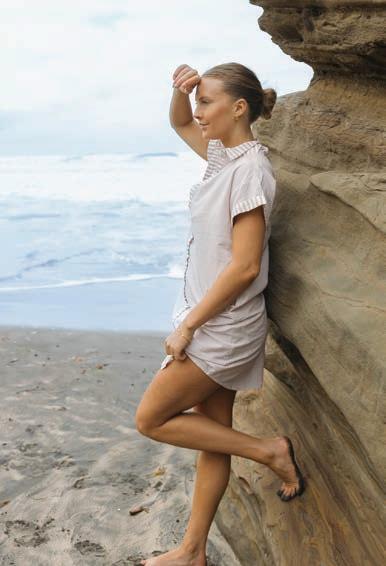













































by Cathy Martin
photographs by Becca Bond
Interior designer Louise Hane believes in creating highly personalized spaces, rich in art, color and furnishings that reflect her clients’ distinct backgrounds and stories.
In this Highlands home, the Rock Hill, South Carolina, designer created











a two-room sanctuary tailored around the homeowners’ existing artwork. The homeowners frequently host family and friends attending local music and art festivals. A bedroom and adjacent office, which share a connecting bathroom, provide a quiet space for their visitors to relax or catch up on work.
The focal point in the office is a framed antique quilt, gifted by the home’s previous owner. Pulling from the quilt’s rich colors and intricate design, Hane incorporated hues of sienna red, indigo blue and citrus orange in the rug and fabric for the roman shades and a pair of upholstered armchairs.
The bedroom is primarily used by the homeowner’s adult son, a wildlife photographer based in Charlotte. Schumacher’s Bora Bora print, used for the window treatments and bedding, was the basis for the design. The linen fabric is inspired by Polynesian tapa, or bark cloth. Framed photographs were taken by the son; Hane pulled in furnishings and accessories in earth tones and natural textures to complete the design.
“This was a dream project for me since [the homeowner] and I have the same deep love of art, color and texture,” Hane says. SP






SOCO Gallery celebrates 10 years of amplifying local talent — and attracting museum-quality artists to Charlotte.
by Cathy Martin
By square footage, SOCO Gallery, founded by Chandra Johnson in 1995, might be one of the smallest art galleries in town. Housed in a charming 1920s bungalow on Providence Road, SOCO shares space with menswear boutique Tabor and Not Just Coffee.
But don’t let its modest size fool you. Over the last decade, SOCO has become one of the region’s premier galleries, showing a highly curated mix of emerging and mid-career artists from across the country, and occasionally beyond. SOCO’s roster includes local artists — including sculptor Grace Stott, photographer Linda Foard Roberts and painter Scott Avett — and acclaimed national artists: Summer Wheat, The Haas Brothers and Clare Rojas, to name a few.
To celebrate its 10-year milestone, through July 30 the gallery presents Layer Cake, an exhibition featuring new works by each of its 28 artists.
Started as a series of pop-ups, the gallery in its early days largely focused on photography. That quickly evolved, and today SOCO represents emerging and mid-career artists working in a variety of mediums. The mission of the gallery is twofold: to introduce new, high-quality artists to Charlotte collectors and to help top-tier local artists expand their reach beyond the Queen City.
“[Johnson] had the vision that she wanted to bring museumquality artists that she was collecting and seeing at all these international art fairs to Charlotte,” says Hilary Burt, gallery director.
“She’s also called it a prism: bringing in outside ideas, but also pushing out the talent that is here. Because there are incredibly talented, museum-quality artists that are here that aren’t getting a national, international platform,” Burt says.
Doing that involves a ton of research, groundwork and relationship-building. Through studio visits, Zoom calls and visits to art shows, Burt and her staff often consult with an artist for one to three years before they show with the gallery.
For emerging artists, the goal is to help the artists reach the next level of exposure.
“We want to be a launching-off point for them, where, because of the exposure that we give them, then they can get picked up by a New York gallery or an LA gallery,” Burt says.



















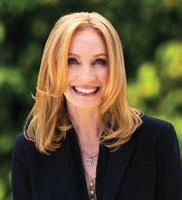



A stage like no other
Nestled in the heart of Newberry, South Carolina’s charming historic downtown, Newberry Opera House is a must-visit destination for anyone seeking world-class performances in an intimate and historic setting.
From operatic melodies and dynamic plays to iconic concerts and family-friendly shows, the Opera House offers an NYC-level cultural experience with the charm and warmth of a small Southern town. Pair your visit with Newberry’s walkable downtown, delicious dining and unique shops for the perfect getaway.
Plan your trip to Newberry, South Carolina, and experience why Newberry Opera House is a true treasure for the arts. We believe that the arts have the power to inspire, connect and transform communities. From thought-provoking stories to unforgettable music, this season offers something for everyone. Visit NewberryOperaHouse.com for tickets, upcoming performances, and more.
1201 McKibben Street, Newberry | 803.276.6264 | NewberryOperaHouse.com

June 20
Listen To Her Heart: A Tom Petty Tribute
July 11
Electric Avenue
July 18
Jackson Truluck and The Gravel Road Show
August 8
10,000 Maniacs
August 22 A Thousand Horses
See the full schedule on our website & our family friendly Summer Movie Series!

When searching for emerging or mid-career artists, the gallery looks for a diverse mix of not only mediums and techniques but also narrative voices. Price point and an easy working relationship are also key factors.
To further the gallery’s mission of lifting up artists, SOCO has published several books for artists and regularly attends international art fairs, including the Armory Show in New York, NADA Miami and the Dallas Art Fair.
“Those art fairs are an investment in our artists,” Burt says, expanding the artists’ geographic footprint with the ultimate goal of getting them placed in esteemed private collections.
With the gallery’s expansion into art fairs and publishing, its collector community has evolved, too, growing beyond its Southeastern roots.
Still, that hasn’t stopped SOCO from working hard to place works in the hands of local and regional collectors.
“We want to build those collections here,” Burt says. She calls it matchmaking.
“I lead with information: This is why this artist is important, this is what they’re doing. And then if someone loves it, I give more information. And then if that’s a good fit for them, fantastic.”
At SOCO, it’s not all about landing a big sale.
“Another goal is to make sure that we’re really presenting experimental work that’s of museum quality, and of artists who are doing alternative work that might not be so commercial, and push that as well,” Burt says.
Soil and Stars, a recent exhibition by Allison Janae Hamilton, is an example. The Kentucky-born artist’s vintage fencing masks, adorned with wooden flowers or rhinestone fringe, were inspired by an image of Black American WWII soldiers engaged in the sport. Intricately crafted and representing a disruption of social hierarchy, the masks might not share the universal appeal as the colorful geometric paintings by Halsey Hathaway, another gallery artist.
While the works at SOCO might exceed the price point of many casual art enthusiasts, the gallery’s shop sells books, small ceramics, candles and other giftable items. And SOCO’s bright, inviting location in the shared bungalow lends itself to browsing: grab a latte, peruse the art, leave inspired.
“Once [artists] come here, they love it,” Burt says. “I don’t have to convince them to show with us again.” SP
Layer Cake, a group exhibition of new works by 28 artists, is on view at SOCO Gallery through July 30.




FIRST LOOK
by Michael J. Solender | photographs by Justin Driscoll
Mazi, a new Mediterranean restaurant in South End, is energetic and contemporary, evoking the feel of a buzzy city bistro. Tufted green banquettes run along one side of the deep rectangular space, while artichoke-shaped lights cast a warm glow.
Back in February, Built on Hospitality chef and partner Chris Coleman was deep into the physical buildout and menu development for Mazi, the Charlotte restaurant group’s fifth concept. Just weeks from opening, he was still searching for a chef de cuisine to oversee day-to-day kitchen operations when mixologist Bob Peters — the Charlotte cocktail guru behind Mazi’s beverage program — introduced him to chef Whitney Thomas. Thomas, 37, a Reidsville native, had just wrapped filming
on Gordon Ramsay’s cutthroat culinary show Hell’s Kitchen. A veteran of high-profile spots like uptown’s 5Church (now Church & Union), Fahrenheit and, more recently, Atlanta’s Serenidad and Marcus Bar & Grille, she had returned to Charlotte ready for her next chapter.
Coleman, 41, is one of Charlotte’s most recognized culinary native sons. He’s led kitchens at The Goodyear House, Old Town Kitchen & Cocktails, Stoke and McNinch House. He’s also competed on — and won— Food Network’s Beat Bobby Flay, Chopped and Alex vs. America.
“I knew of chef Whit’s reputation,” Coleman says. “I’d eaten her food at 5Church.” Though their paths had crossed around Charlotte, this was their first sit-down.
Experience















One hour into their conversation, Coleman offered Thomas the chef de cuisine role, and she accepted.
“It was clear she wanted to grow and make a name for herself,” Coleman says. “We wanted a chef who could build their own identity.”
For Thomas, Mazi was the perfect next step.
“I’m ready to lock in for the next four or five years, build my brand, and then do my own thing,” she said. “I want to focus, grow and eventually have my own space.”
Mazi, which means “together” in Greek, reflects Coleman’s belief in food’s power to unite and celebrate community. Though rooted in Mediterranean flavors and techniques, the menu of mostly small, shareable plates also showcases local Southern ingredients.
“I try to represent Charlotte and the Piedmont in everything I’ve done,” says Coleman, a founding member and past chair of the Piedmont Culinary Guild. “This area has deep agricultural roots, and I’ve always highlighted that. Now, I get to support chefs like Whit, Tyler Long at Goodyear House and Drew Carter at Old Town Kitchen, who honor the region as well.”
Thomas makes it easy to enjoy bold southern and Mediterranean flavors in every bite. Her black walnut muhammara puts a Southern twist on the Turkish staple: a base of roasted peppadew peppers is blended with black walnuts and olive oil, then dotted with pomegranate seeds. Served with crisp crudités and grilled house-made flatbread, it’s the kind of dish diners want more of.
Small-cup oysters are simple and elegant, served chilled with a preserved lemon mignonette that adds a bright citrus pop. A chilled carrot salad defies its modest name. Grilled carrot planks — cooled and dressed


e Village on Morehead has ushered in sophisticated retirement living in the Queen City. Surrounded by the heritage neighborhoods of Eastover, Myers Park and Dilworth – its impeccable nishes, Aspenwood service detail, dining and resort-style amenities make it the premier address. Impressive, spacious residential oor plans, oor to ceiling windows, expansive terraces allow a new level of indoor-outdoor living. Spaces designed for entertaining, tness, relaxation and a dedicated team provide a secure, lock and leave lifestyle for members.
Our approach to customized living continues by partnering with an accredited home care provider that serves you in the comfort of your residence. Making things easy, private and reliable when you need on-site health and wellness services. From personal care to therapy – nursing to companionship services, you can rely on a care plan that ts with your needs and schedule.


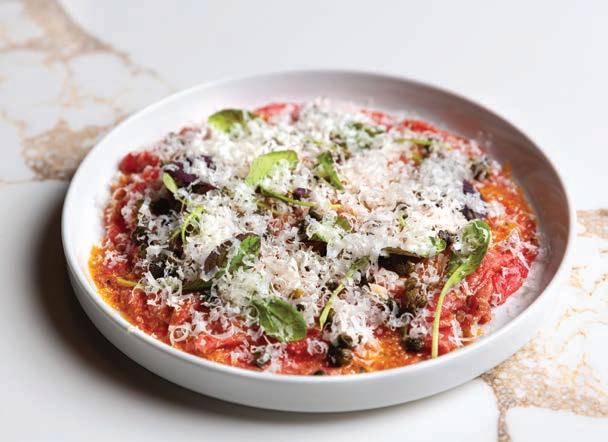


in pomegranate, pickled apricots, red onion and a crunchy seed mix — are layered with cumin, turmeric and warm Mediterranean spices.
“My flavors are bold,” Thomas says. “I want diners to know that.”
Vegetarian dishes shine, like the Lion’s Mane Mushroom Shawarma wrapped in a blanched collard leaf and dressed in garlicky aioli. The Falafel-cini reimagines Italian arancini, using Carolina Gold rice to form airy falafel balls served with tangy green shug (a Yemini condiment) and a caramelized onion dip.
Carnivores aren’t left out. The M’battan layers impossibly thin-sliced potato with beef and a spicy tomato sauce — like lasagna without the cheese, yet equally comforting. A slowbraised lamb shank with olive gremolata is perfect for sharing and comes with a nutty freekeh (durum wheat) risotto.
Mazi’s cocktail program features both classics — Aperol spritz, negroni, old-fashioned — and new favorites like the Tamarind Tequila Sour (fresh tamarind syrup, reposado tequila, orange twist). The signature Mazi Cocktail blends Social House vodka, pomegranate liquor, lemon and mint syrup for a bright, balanced drink.
The baklava sundae — a nod to Baked Alaska — is a sweet closer: walnut cake and honey yogurt gelato topped with a mountain of browned Italian meringue. SP
Mazi is located at 1300 South Blvd #101F. maziclt.com

















Leluia Hall is now open in Dilworth, in the 1915 former church that previously housed Bonterra. On the “steak and surf” menu: lobster Thermidor, salt- and sugar-cured steaks, tiny tacos and sea bass ceviche. Moo & Brew founder Zach Current and Crissy Oliver will open Painted Rooster in the former Zada Jane’s spot in Plaza Midwood. Expect wings, tenders, mac-and-cheese, salads and a dogfriendly patio. Copain Bakery & Brasserie will open in late 2025 at the Bowl at Ballantyne. Along with artisan breads and pastries, the brasserie will serve salads and sandwiches for lunch and classic French dishes like coq a vin and dry-aged steaks at dinner.


LAKE pajamas will open this summer at Specialty Shops SouthPark. LAKE is known for its signature pima cotton sleepwear and loungewear for men, women and children. Voyage opens this month at Camp North End. Founded by Charlotte’s Ophelia Allman, the shop will sell women’s clothing, accessories and travel items and host workshops from packing tutorials to vacation planning. Warby Parker opened its third Charlotte store at Waverly. Reformation will open at SouthPark Mall this fall.



DRINK PINK: Throughout June, more than two dozen restaurants across Charlotte will offer pink cocktails, frose, lemonade and more, with proceeds benefiting Madelyn’s Fund. The nonprofit started by Rachel and Andy Lee supports NICU families facing unexpected costs. For a list of participating restaurants, visit madelynsfund.org/ drinkpink or check Instagram @madelynsfund



















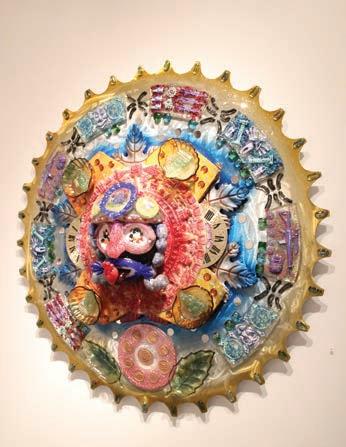
The Paglees: Between Reason and Madness through June 28 Seven South Asian women artists living and working the U.S. formed a collective in 2020. Now, they bring this group exhibition — which debuted in Chicago and challenges patriarchy, colonialism and power — to McColl Center.
OceanXperience at Discovery Place through Sept. 7 Climb aboard a replica of a marine-research vehicle and learn about humpback whales, hammerhead sharks and more in this traveling exhibition.
Monopoly Lifesized through July 27 Family fun at Blume Studios: Roll the dice, buy properties and build houses with challenges along the way as you compete against other teams. Helpful guides keep score and keep the game moving. Standard tickets start around $50.
Taste of Charlotte
June 6-8 The city’s largest food festival returns to uptown for three days. Try small bites ranging from local barbecue to sweet treats. Free to attend, but tastings require the purchase of festival coins on-site.
Savannah Bananas vs. The Party Animals
June 6-7 The games at Bank of America Stadium are sold out, but you can try your luck on ticket resale sites.

Bowl Street Popup Market
June 7 | 10 a.m.-3 p.m. Shop from local artisans and makers at this monthly market on the green at The Bowl in Ballantyne.
Barenaked Ladies: Last Summer on Earth Tour 2025
June 7 The pop-rockers behind hits like “One Week” and “It’s All Been Done” play Skyla Credit Union Amphitheatre.
Collidoscope: de la Torre Brothers Retro-Perspective
June 7–Sept. 21, 2025 This exhibition at Mint Museum Uptown includes 40 mixedmedia works (blown-glass sculptures, installations, lenticular pieces) by brothers Einar and Jamex de la Torre. The works are inspired by Mexican folk art, pop culture and mythology.
June 8, 15, 22 and 29 The beloved Charlotte Symphony Orchestra series returns for a 42nd season with Classical’s Greatest Hits, Best of Broadway, Latin Sounds and Celebrate America with fireworks on June 29.
“The Lost Years” Summer Blockbuster Movie Series
June 8 - Aug. 28 This 13-week movie series at Carolina Theatre offers a big dose of nostalgia. June films include Fist of Fury,
Star Wars: The Empire Strikes Back, Raiders of the Lost Ark and E.T. the Extra Terrestrial
The Speakeasy at Discovery Place Science
June 14 Explore the libations of the Prohibition Era at this annual one-night-only event for the 21+ crowd. Attire inspired by the 1920s is encouraged. Tickets are $34, with a VIP option for $64.
Modest Mouse
June 15 The indie rock band from Portland comes to The Fillmore for a summer tour with faves like “Float On.”
Fred Armisen
June 18 The award-winning comedian (SNL and Portlandia) and musician comes to The Fillmore for his Comedy for Musicians But Everyone is Welcome tour.
Real Madrid CF vs. CF Pachuca
June 22 The FIFA World Cup match will be held at Bank of America Stadium. Tickets are $50-190. SP
Scan the QR code on your mobile device to stay updated on events at southparkmagazine.com.




















by Liza Roberts

On a sprawling industrial site on the banks of the Catawba River, beyond a cabinet-maker, a boat rental and a rum distillery, past hundreds of pallets of overstocked, shrink-wrapped, big-box merchandise, lies a repository of an entirely different sort.
Here, in an open 5,000-square-foot space, stand sculptures, paintings, drawings, prints and multimedia creations that address, mostly through abstraction, many of the issues of our time: race and memory, history and geography, stereotype and expectation, imagination and potential. This is the studio of artist Juan Logan, where he creates and stores the work from a career spanning more than 50 years. He is one of our state’s most accomplished contemporary artists, and one of its most prolific.
In May, a major exhibition of his work, Without Stopping: Juan Logan, opened at the Mobile Museum of Art in Alabama, where it will run until Feb. 14, 2026. Featuring 48 works from Logan’s decade-long Elegies series, including many never before seen in public, the exhibit will feature a massive new piece commissioned by the museum to commemorate the residents of Africatown. The area of Mobile was founded by the descendants of enslaved people brought in 1860 to Mobile Bay aboard a wooden ship called the Clotilda. At six-and-a-half feet tall and 16 feet wide, Logan’s commissioned piece, Elegy CLXXXVI, Without Stopping, is by far the largest of this seminal series.
“I think of it as a series on memory, but not just mine,” he says. “Collective memories.”
Though the word “elegy” often refers to a poem for the dead, “it can also mean a serious reflection,” Logan says. With abstract shapes and symbols, Logan reflects on the fragmented, imperfect and haunting nature













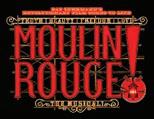



















of memory, including cultural memories shared in various and ever-changing ways. He mentions the Japanese notion of wabi-sabi, which finds beauty in imperfection and impermanence.
“There are no perfect memories. And I don’t have any trouble portraying them that way.” Forgotten memories, too. “The absence of memory, how it depletes us … how it kills us. It leaves us very alive, but missing so much. We are so sure we hold on to things, even happy memories, but they fade away as well.”
A repeated image throughout his work, beginning in the late 1970s and regularly appearing in his Elegies series, is the silhouette of a black head. The subtle shape shows up in painting, drawing, collage and sculpture (including Beacon, outside the Gantt Center) as a symbol of memory, loneliness and identity, and of the Black experience.
Lately, the head shape on its side may represent a boat, Logan says — a boat transporting memories, knowledge, thoughts, hopes and ideas. “Sometimes it’s completely filled, sometimes it’s empty. Such is the nature of humanity. We hold on to things, we lose things.” But always, he says, the head represents humanity. “All of our imaginings, and everything we ever were or will be takes place there first. It is who we are.” The featureless cameo offers a blank-slate Rorschachian challenge to the viewer: What do you fill in here?
Other symbols that make regular appearances in Logan’s colorful, abstract work include starry skies, clouds, maps and boats. Like a poet, Logan uses these allegorical images in individual works and as leitmotifs to represent many things: the collective unconscious; the workings of the world and the role of the individual in creating it; reserves of knowledge; the power of
imagination and perception. Most important, Logan says, is not what he says these things mean, or what his own point of view might be, but what they provoke or challenge in the viewer.
Logan has been challenging viewers over the decades of a celebrated career that spans the globe. He has pieces in the permanent collections of some of the nation’s foremost museums, including the Whitney Museum of American Art, the Philadelphia Museum of Art, the Smithsonian’s National Museum of African American History and Culture, the Baltimore Museum of Art and the Mint Museum.
Wearing the uniform of black T-shirt and jeans that he has made his own for at least 40 years, the former UNC Chapel Hill professor of studio art is a voluble host in his Belmont studio, eager to unpack the meaning and message of his work, which surrounds him in a vibrant, living archive. He does it through story.
There’s the story of a treacherous treadmill used to try to break the spirit of enslaved people in Jamaica in 1837. That inspired The Sugar House, a 16-foot canvas of paint, glitter, lottery tickets and thousands of glued-on puzzle pieces.
There’s the story about Harold McLean, a high school shop teacher who encouraged him to make his first work of art, an eagle carved of white birch. McLean told Logan that what he made didn’t have to be like anyone else’s. “It can just be yours,” the teacher said. The words unleashed something in Logan: “It changed everything.”
There’s the tragic story of his father dying of a heart attack after a doctor didn’t believe his chest pains were real. It’s an example,







Logan says, of racial bias, and one of his many inspirations for work that address injustice, oppression and alienation.
And then there are the many stories of home. The shape of a canted roofline in one of his works has him describing his own 114-year old house, which was built by his great-grandfather and grandfather. It’s a 10-minute drive from his studio in a neighborhood Logan illustrates with a quickly jotted map.
“Here’s my house right here. Here’s my mom’s house over here. Here’s my aunt’s house, here. There’s another aunt here. Here’s my sister’s house, here. Here’s my uncle’s house down here. And then my grandfather’s road, that’s named after him …” The foundation of another house his great-grandfather built out of handmade bricks and lived in after slavery still stands in the woods nearby. “These things serve to anchor you in a particular way,” Logan says. “I think more than perhaps other places, the South does that for so many people.”
“For many years now,” Logan says, “I’ve tried to simply ask better questions. I think that’s the only thing that allows us to deepen our investigations about what we’re doing, regardless of discipline. If we can ask better questions, we’ll learn more, be able to do more.”
Doing more is clearly not a problem for Logan. At any given time, he’s got a dozen new projects in various stages underway. In addition to the Mobile show, his work will be featured in an exhibit in Chattanooga in July and one on American and German abstractionists in Berlin in October.
“We want so much out of this,” he says. “And we are here for such a brief period of time. So we try to do as much as we can for as long as we can, with the hope that someone will take the time to preserve it and pass it on and share it with others.” SP
Liza Roberts is the author of Art of the State: Celebrating the Art of North Carolina, published by UNC Press.

compiled by Sally Brewster
So Far Gone by Jess Walter Rhys Kinnick has gone off the grid. At Thanksgiving a few years back, a fed-up Rhys punched his conspiracy-theorist son-in-law in the mouth, chucked his smartphone out a car window and fled for a cabin in the woods, with no one around except a pack of hungry raccoons. Now Kinnick’s old life is about to land right back on his crumbling doorstep. Can this failed husband and father, a man with no internet and a car that barely runs, reemerge into a broken world to track down his missing daughter and save his sweet, precocious grandchildren from the members of a dangerous militia? With the help of his caustic ex-girlfriend, a bipolar retired detective, and his only friend, Kinnick heads off on a wild journey through cultural lunacy and the rubble of a life he thought he’d left behind.
The River Is Waiting by Wally Lamb Corby Ledbetter is struggling. New fatherhood, the loss of his job and a growing secret addiction have thrown his marriage into a tailspin. And that’s before he causes the tragedy that tears his family apart. Sentenced to prison, Corby struggles to survive life on the inside, where he bears witness to frightful acts of brutality but also experiences small acts of kindness and elemental kinship with a prison librarian who sees his light and some of his fellow offenders, including a tender-hearted cellmate and a troubled teen desperate for a role model. Buoyed by them and by his mother’s enduring faith in him, Corby begins to transcend the boundaries of his confinement, sustained by his hope that mercy and reconciliation might still be possible.
The Lost Masterpiece by B.A. Shapiro
In a gripping novel full of plot twists, B.A. Shapiro embeds us in a circle of famous painters in late 19th-century Paris, centering on the anguished impressionist artist Berthe Morisot and the story of Morisot’s great-great-greatgreat granddaughter, Tamara Rubin, who has inherited Édouard Manet’s Party on the Seine Tamara discovers a long-hidden family history
replete with unanswered questions: How had the painting been stolen by the Nazis? How had the painting managed to survive three disasters that destroyed every other artwork around it? And most of all, why had she never known about her ancestor, Berthe Morisot? As the painting begins to metamorphose into darker and more terrifying versions of itself, Tamara’s ordinary life is thrown into turmoil. What wounds and resentments plagued Morisot, and to what lengths will her spirit go for revenge?
Burning Down the House: Talking Heads and the New York Scene That Transformed Rock by Jonathan Gould
One of the foundational bands of New York’s downtown 1970s music scene, Talking Heads have endured as a musical and cultural force for decades. Their unique brand of transcendent, experimental rock remains a lingering influence on popular music, despite their having disbanded over 30 years ago.
Now, New Yorker contributor Jonathan Gould offers an authoritative, deeply researched account of a band whose sound, fame and legacy forever connected rock music to the cultural avant-garde. From their art-school origins to the enigmatic charisma of David Byrne and the internal tensions that ultimately broke them apart, Gould tells the story of a group that emerged when rock music was still young and went on to redefine the prevailing expectations of how a band could sound, look and act.
More than just a biography of a band, Gould masterfully captures the singular time and place that incubated and nurtured this original music: downtown New York in the 1970s, that much romanticized, little understood milieu where art, music and commerce collided in the urban dystopia of Lower Manhattan. What emerges is an expansive portrait of a unique cultural moment and an iconoclastic band that shifted the paradigm of popular music by burning down the house of mainstream rock. SP Sally Brewster is the proprietor of Park Road Books, 4139 Park Rd., parkroadbooks.com.




Sick visit? Same-day appointment? Annual physical?
Start with us!

We know you value convenience as well as quality care. That’s why we make it easy for our patients—including those who are new to Tryon
Whether it’s for a sick or well visit, you can always count on us to offer an appointment that works for your schedule, even the same day.
If you haven’t already experienced the Tryon difference, now is the time. Our award-winning clinicians are welcoming new patients and building stronger relationships at multiple locations throughout the Charlotte area.
Book your appointment today at tryonmed.com
And the power of the Earth to heal by Jim
Dodson
One morning this past February, I stepped out to assess how my garden had fared from one of the coldest, soggiest winters in memory.
It wasn’t a pretty sight. The Asian-themed shade garden I’d spent a decade creating under towering oaks appeared to be devastated, buried beneath drifts of sodden leaves and dozens of downed tree limbs. The only visible signs of life were weeds and grass creeping over the garden beds like an insurgent army.
I’m no rookie in landscape gardening. I’ve built — and restored — three major gardens in my life, including an ambitious native garden in a forest on a coastal hilltop in Maine, where we lived for two decades.
Hard weather, as they say up in Maine, makes good timber — a theory, I’ve discovered, that’s applicable to human beings as well as gardens. I remembered this eternal truth as I took stock of my battered garden, wondering if it would ever look as glorious as it did last summer.
After a morning of clearing debris and raking out beds that showed little to no signs of life, I ruefully joked to my wife Wendy that our “ruined” garden was the final insult from a winter we were both eager to forget.
It started on All Saints’ Day back in November, with the death of Wendy’s mom, who had spent her career teaching children how to love art. In the end, dementia robbed “Miss Jan” of her sparkling wit and even the ability to recognize those she
loved. At least she spent her final days on our terrace, warming her face in the late autumn sunshine. The last thing she said to me was, “Look, isn’t the sun beautiful today?” She never spoke again.
For the first time ever, three of our four adult children failed to make it home for the holidays, which made for a too-quiet house at Thanksgiving and lots of empty stockings. Fortunately, our youngest, Liam, showed up two days before Christmas, briefly brightening the mood before I went under the knife for a full left-knee replacement that left me wondering, as the New Year dawned, what dump truck ran over me.
I skipped the narcotic painkillers in favor of Tylenol, however, because I was under the intense pressure of a tight deadline to correct and return my editor’s marks on the most important book of my life. To make things more fun, as I wrestled with a hoisted leg and a complex digital editing system, a work crew arrived to renovate our Donna Reed-era primary bathroom, knocking down walls and pulling up floors — making such a god-awful racket, it seemed they were taking out half the house.
Most disturbing of all, amid this clamor and craziness, I lost my longtime gardening pal, Boo Radley, our beloved 14-year-old cat.
Every family, of course, goes through periods of intense stress and challenge when the chaos of life seems to pile up like snow against the door. That’s just part of the human journey. To place our winter of discontent in proper context, as my late Scottish father-in-law liked to say, ours were “pretty






high-class problems in a world that is full of sorrow and woe.”
It took an unexpected birthday card from my dear friend Ashley to lift my cloud of gloom and remind me of what’s really important in the grand scheme of things.
Her clever card amounted to a gentle poke from the universe, depicting an old, gray rabbit nibbling something in the garden. She knows I have a thing for woodland rabbits.
“Another year,” read the card. “Another gray hare — Happy Birthday!” But it was her accompanying handwritten message that reminded me of the lessons in gratitude and joy we’ve shared over the many years of friendship:
“In all seriousness,” she wrote, “thank you for showing me the joy of growing backwards … The secret, perhaps, to this wild, wonderful life on Earth.”
The idea of growing backwards is simply our way of describing a life in tune with nature, timeless values that promote kindness and compassion to all living creatures and a deep reverence for the Earth.
In a year that has already seen apocalyptic wildfires out West, a record number of killer tornados in the heartland and a hurricane that will be remembered for generations, it isn’t much of a stretch to realize Mother Earth is sending us a serious message about our behavior.
Last November, Ashley and her husband Alan nearly lost everything they own — including their lives — when their first home on a pretty hillside just outside Asheville was almost washed away by Hurricane Helene.
“At the height of the storm,” she remembers, “we were huddled in our house with our dog, Dirga, watching frightening torrents of water roar down the mountainside, washing away many of the houses around us. I remember asking Mother Mary to please keep us safe.”
Moments later, the couple heard a loud crash of trees that fell directly in the path of the rampaging waters, diverting the flood away from their home.
It was, she says, “a miracle. Nature saved our house.”
After sheltering with friends outside the danger zone, the couple returned to find their home still intact but surrounded by a world of mud and debris.
“Helene brought me back to a higher level of consciousness, a desire to let go of things that don’t really matter in the course of daily life,” she says. “It also brought out an amazing amount of kindness and support among complete strangers who helped each other through the crisis. I think it changed many lives.”
The good news, she says, is that her bare yard is now a blank canvas awaiting the creation of a wonderful new garden.
Days after she told me this, she sent me a photograph of the lone plant that miraculously survived the great flood — a single, gorgeous tulip that popped up with the coming of spring. “Nature always gives us a gift,” she wrote.
That same afternoon, I noticed my own garden miraculously springing to life.
Come June, it should really be something. SP
Jim Dodson is a writer in Greensboro. His 17th book, The Road That Made America: A Modern Pilgrim Travels the Great Wagon Road, will be published on July 1 and is available for pre-order on Amazon.





Tuesday, June 24











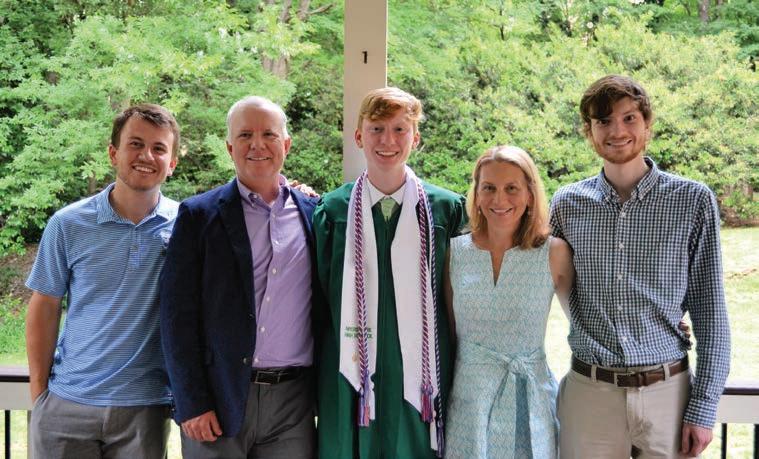
Ace The Stigma supports children and adults suffering from mental illness.
by Michelle Boudin
Mike Reiney admits, forming and running a nonprofit wasn’t something he ever thought about. That changed when the unthinkable happened.
“It was not in my life plans at all, but it all came to be with the death of my brother, Chuck, on February 9, 2023.” Chuck Reiney moved to the Queen City 20 years ago for a job in IT consulting and eventually worked for Wells Fargo. The father of three was an avid tennis player, often found on the courts at Olde Providence Racquet Club, where he served as president beginning in 2020.
His love for the sport came early, when he and his three siblings played on the backyard court their parents built in their hometown of Jacksonville, Florida
“He was the kid in our family that was the smartest,” says Mike, describing his brother. “He was second in his class in high school, he got a near perfect score on the SAT, got every girl — everything came easy to him.”
Later in life, things seemed to continue on the same path. Chuck was married for 25 years and had plenty of friends. His baby brother seemed to have it all, Mike says.
“From the outside, you would never know he ever had a worry in his life. The thing is, up until the last three months, I’d never known him to struggle with much of anything. And then, he seemed to just fall to pieces.”
When Mike realized his brother was struggling with his mental health, he asked him if he’d seen a therapist. But Chuck was reluctant.
“There’s just a stigma around getting help and taking care of yourself from a mental standpoint,” his brother says. Mike believes Chuck was close to getting help, but didn’t.
“On February 8, the day before he died, he reached out and said ‘I’m struggling bad, I’m thinking about harming myself.’” Mike again encouraged his brother, who was 53, to find someone who could help him.
The next day, the news was devastating: Chuck had taken his own life.
The family planned a memorial service on the tennis court he’d loved so much. Five hundred people showed up. While there, friends and family spoke about hosting a tennis tournament to honor Chuck and raise money for others suffering from mental illness.
“I talked it over with our family, and we decided we felt brave enough that we could share our story to help people — because nobody should have to go through this like we have.”
The family officially formed the Ace The Stigma nonprofit in 2023 with a mission of ending the negative stereotypes around mental health. The first event, a tennis tournament at Olde Providence, raised almost $200,000 for five Charlotte-


area nonprofits that also help people battling mental illness, including HopeWay and the Alexander Youth Network.
In addition to the annual tennis tournament, Ace The Stigma hosts other events throughout the year offering mentalhealth services and resources to attendees.
“It’s humbling,” Mike says “What I’ve learned is that it’s made me feel there are a lot of people who are suffering with their own problems, but also a lot of families who are left behind like our family with no note, nothing to go back on and no answers. Every time we have an event or a session, people come out of the woodwork, because they’re all affected.”
He says each time they get together it helps his family heal

just a little bit more.
“It’s a group-therapy session for all of us. We didn’t see it coming. We wish we would have seen, so if we can just help somebody else … You go to the doctor when you have a sniffle, but you think twice if you have a mental problem and don’t have anyone to talk to. We’re trying to make people feel comfortable … there’s a stigma around mental health, and we’re working to change that.” SP
Ace The Stigma will host its second annual tennis tournament and fundraiser at Olde Providence Racquet Club on June 26-29. Learn more at acethestigma.com.





Renovating your space shouldn’t feel overwhelming, but juggling contractors, missed deadlines, and messy communication often turns a simple update into a headache. That’s where Avid Painting comes in. Founded in 2004 by John Castano, Avid was built on the belief that quality work should come with a smooth, stress-free experience.
We’re not just painters — we’re project partners. From interior and exterior painting to custom tile, molding, carpentry, and more, our detail-oriented team handles it all. Here’s what Charlotte homeowners, Dr. David and Ellen Framm, said about their experience with the Avid team:
“We hired Avid to help update our home’s outdated French Country style (circa 2000) to a clean, contemporary look. John never tried to upsell us, and we love that he always gives his honest opinion. He’ll tell us like it is with a fabulous sense of humor, and bouncing creative ideas off each other has led to stunning results. John has an exceptional work ethic, and we highly recommend the Avid Painting & Home Remodeling team. They’ve become a go-to resource for all our projects.”
Elevating your home starts with a quick call to schedule a free, on-site consultation. You’ll get a detailed estimate in two business days or less.
So, breathe easy — with Avid, your space is always in experienced, dependable hands. We guarantee it!


S A N T A N A L E A T H E R C A R E

DRESSING WELL TRANSCENDS TRENDS. FOR THESE CHARLOTTE MEN — AGES 17 TO 81 — IT’S ALL ABOUT FIT, COMFORT, KNOWING WHAT WORKS BEST FOR THEM — AND CONFIDENCE.
styled and produced by Whitley Adkins
photographs by Olly Yung
photographer’s assistant Peyton Gee
production assistant Sydney Gallagher photographed on location at Rí Rá Irish Pub
Comments have been lightly edited.

TJ Franklin
41, owner of FA & FO Security
My style is an unapologetic reflection of who I am — bold, effortless, and completely mine. I dress based on how I feel, not on what’s trending. Some days I lean into clean lines and structure; other days, it’s all about flow, color and comfort. The one constant: confidence. With age, my style has evolved into something sharper, more intentional and completely rooted in self-awareness. I’ve let go of the pressure to impress and leaned into what genuinely makes me feel powerful, grounded and alive. It’s no longer about doing the most — it’s about doing me, with clarity and ease. Don’t chase trends — chase truth. Your style isn’t something you find in a store or on a runway — it’s already in you.

Michael Gallis 81, real estate developer
I grew up in San Francisco in a time when we were first fitted for suits at age 6. Classic was more important than fashion. For [those of] us growing up in that era, casual is a suit and tie. On the other hand, going up to our vineyard in the Napa Valley was a very different dress and style. Classic was Levi’s and plaid shirts. With age, I have focused more on comfort. My style has become simpler: fewer clothes, but with a wider range of more interesting combinations, from an unusual average to eye-catching. My style icon is Berhan (Nebioglu), my partner. She is a woman with her own style — never in style, but her own, always. She has style even when she cleans the house. It’s an inspiration.
Felipe Fisher
39, interior designer and co-founder of Dancing with the Stars of Charlotte
My style has definitely matured and evolved over the years. It’s less about following every trend and more about understanding what works for me, both in terms of my body and my lifestyle. I’d describe my style as classic with a twist of modern trends. I believe in investing in timeless pieces that can be styled in multiple ways, yet I’m not afraid to incorporate a few trend-driven items each season to keep things fresh and exciting. … Clothing, for me, is not just about appearance but about expressing a mood or a facet of my personality. With age, I’ve become more confident in my sartorial choices, focusing less on what I think I should wear and more on what makes me feel good.


Doug Gravely 60, merchandising director at Taylor, Richards & Conger
As I’ve gotten older, I’ve continued to stay in the lane of ‘classic clothing’ — articles of clothing that can arguably last a lifetime, that one day I can pass on to my son. Advice that I would give to a young man who is trying to identify his own personal style would be to first be a student. Stay away from trends, know the proper rules of dressing, know your fabrics, etc. … There’s nothing wrong with experimenting, but first know the history and have some sort of semblance of menswear.
Wesley Mancini 72, textile designer
I’m definitely eclectic, nonconforming and stand out in a room. I try to be youthful, tasteful (which is a relative term), creative, unique in both combinations and items, comfortable, but most of all, I want to feel good in how I present myself. As a textile designer, I maintain an image of being creative, refined and fresh. Wear what makes you feel attractive, sexy, safe, comfortable and situationappropriate. Don’t let others dictate who you are and what you wear.

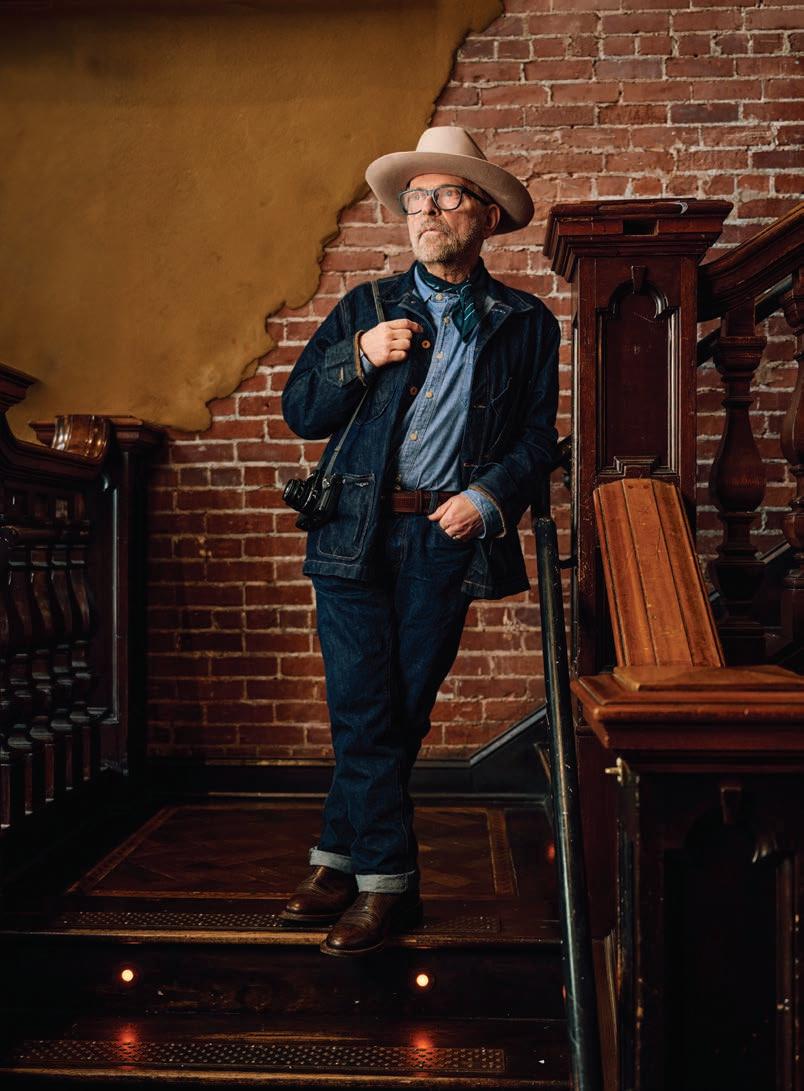
Richard Israel 69, photographer
Over the years I have adopted a passion for western/ workwear-inspired style and most certainly raw denim. I wear variations of this look on a daily basis. My attitude to dressing is solely dependent on what I’m doing that day, which can be a shoot in the wild forest, a client meeting or shooting a wedding. Wardrobe fit, appropriate style and comfort are always paramount. My style has become more intentional, thoughtful and considerate with age.
Hank Hamlin 17,
student
I dress casual without looking like a dirty rag or like I’m at the gym. My style has evolved from athletic clothing into a more put-together look. I like to wear my band T-shirts from The Elovators and The Hip Abduction because of their graphic design. They’re something I wear on the daily, to school and while spending time with friends and family — something casual but good-looking. My [dressier] look, all by Tabor, is classy and something I would wear to events and special occasions. Like myself, I would tell a young guy to try different looks until he finds his style. SP


A new-to-Charotte homeowner updates her Heydon Hall abode with an ultra-modern vibe, returning to the trusted expertise of interior designer Jacy Painter Kelly.
by Catherine
Ruth Kelly
| photographs by MB Productions
KK Kucharski relocated to Charlotte from Chicago in 2020, following two of her three daughters to the Queen City and knowing she would likely have grandchildren here one day. Five years, two grandchildren and three houses later, Kucharski finally feels settled in her new hometown and her new home after renovating last summer and moving in last fall.
“I really like this neighborhood,” says Kucharski. “It’s so peaceful, quiet and safe, and I love that it is gated and that my yard is taken care of.”



Situated on a manicured lot in the Heydon Hall community in south Charlotte, Kucharski’s house was built in 2004 but required a bit of updating. Kucharski oversaw renovations of the kitchen and bathrooms. For the interior design, she consulted Jacy Painter Kelly, based in Fort Mill, South Carolina.
“This was actually my third project with KK,” says Kelly, who started working in interior design in 2004. “We got to know each other during the first project and worked well together, so by the third time around it was so easy because I know her style.”
Kelly’s signature style is decidedly modern with clean lines and a primarily black-and-white color palette. As a result, she tends to draw a certain type of client.
“The clientele I attract is a little more casual and more edgy in general,” explains Kelly. “I don’t do southern floral or shabby chic, and my clients know that; I attract clients who are a little out of the box.”
Kelly kept the dining room casual yet chic, selecting a round table for the pass-through space. Knowing her client’s taste, she
commissioned a black-and-white geometric patterned rug to fit the room.
“KK has a real thing for bold rugs, so I knew she would like this,” Kelly says. “We didn’t want the dining room to be too formal, so the fun pattern play kept it approachable and interesting.”
Kucharski’s goal during the kitchen renovation was to open it up to the living room and create a larger central island. She didn’t want a black-and-white kitchen, so Kelly helped her select a warm, earth-toned stain for the custom cabinetry by Distinctive Cabinets. There wasn’t enough room for a breakfast table, so Kelly suggested adding a pair of swivel chairs for soft seating beside the kitchen windows.
“That small sitting area is my morning spot where I have coffee and watch the deer walk through my backyard,” says Kucharski. “It’s so peaceful and relaxing.”
Another bold black-and-white rug anchors the living room, where a pair of creamy white sofas provide a comfortable gathering space. The fluted soapstone fireplace surround echoes

Corbett Lighting’s “Lariat” chandelier is the centerpiece of the living room, where a pair of paintings by Whitney Stoddard flank the fireplace.
Opposite page: Shades of grey create a moody atmosphere in the primary bedroom, where Kucharski opted to use the same Thibaut wallpaper and Arteriors chandelier from the bedroom in her last house.
the fluted wood in the kitchen above the stove and on the island. A brass light fixture featuring draped chains is the centerpiece of the room.
The black-andwhite theme continues throughout the house, with pops of color introduced via art and accessories. Kelly says it can be challenging to create neutral spaces that still exude character.
“I really try to layer in different textures so it doesn’t feel bland or generic,” says Kelly. “My goal is to make it comfortable and welcoming and not sterile so people feel at home.”
Kucharski appreciates the clean, modern aesthetic that Kelly designed for each of her houses. After working on three projects together, they have an easygoing relationship.
“Jacy and I collaborate well on design choices, and I know I will like most of the items she shows me,” Kucharski says. “It makes it so much easier when you’re working with someone who knows your taste because you’re not wasting any time.” SP




Elizabeth Lawrence found magic in each new leaf and flower in her Myers Park garden.
by Jay Sifford | photographs by Dustin and Susie Peck
In the middle of the 20th century, a lazy side street in Myers Park became an unassuming epicenter of Southeastern horticultural history. There, on Ridgewood Avenue, two legendary plantswomen named Elizabeth Lawrence and Elizabeth Clarkson forged a friendship, and two very different gardens.
Clarkson’s private garden became known as Wing Haven Garden & Bird Sanctuary, opening to the public in 1970. Born in 1904, Lawrence is legendary in another way: In 1932, she became the first female graduate from N.C. State University’s landscape architecture program. Her garden stands as a testament to both her prowess as a landscape architect and her willingness to experiment with plants from around the world to determine which flourished in the heat, humidity and clay of the upper South.
The one-third-acre garden became her teacher. Her hands-on research led to multiple books and magazine articles and over 700


gardening columns for the Charlotte Observer. She received awards and special recognition from The Charlotte Garden Club, American Horticultural Society, North American Rock Garden Society and many other groups.
Lawrence was one of this country’s best writers of garden literature, says Andrea Sprott, former longtime curator of the garden.
“She wrote about Southern gardens, but her appeal was universal. Someone once said that she had a pen in one hand, and the other hand in the soil.” According to Sprott, Lawrence was quiet, introverted and quick-witted.
“She was impish, sparkly, diminutive and very complex. She never lost her childlike sense of wonder, always being in awe of a newly opening flower or unfurling leaf.” The magic is the common thread in both her writings and in her garden.
She had a great interest in native plants and was a member of the North Carolina Native Plant Society. However, she didn’t discriminate. She loved plants from everywhere. Case in point: She brought a beloved clump of bamboo from her previous home in Raleigh and planted it outside a side window. She loved its shadows and movement, and enjoyed watching the cardinals that sought shelter in it. We now know that this bamboo is invasive. But, since it is a historically significant part of the garden, it remains, contained by a buried bamboo barrier.

Lawrence had no planting plan and only one drawing of the overall layout when she began crafting the garden in 1948.
“Her vision in mapping her garden was really brilliant,” says Sprott. By aligning the hardscape with prominent windows, she created a bespoke dialogue between house and garden. The sprawling, informal planting plan softens the hardscape and offers a tranquil, relaxing vibe that warmly welcomes visitors.
The house, unassuming by current Myers Park standards, is hidden from the street by a tall camellia hedge. A simple pea gravel parking pad creates necessary negative space when viewing the billowing front planting beds. Many of these plants are original to the garden.
The back garden is laid out in sections. The upper garden, which welcomes visitors as they round the corner of the house past Lawrence’s beloved bamboo, is on axis with the main part of the house. Lushly planted beds pull the visitor to a circular goldfish pond, then to a woodland garden that terminates at a plaster installation of the Madonna and Child, Lawrence’s favorite part of the garden.
A short run of stone steps leads down to the lower garden. Here, Lawrence created a separate space that is delineated by five cherry laurel trees to add structural balance. These trees elicit curiosity of what lies beyond and create a bit of mystery. Perennials proliferate and seed into the walls here, a practice that is celebrated by the current staff.
Sprott scoured thousands of pages of Lawrence’s writings in order to emulate her passion for cultivating heirloom plants, both native and exotic, while trialing



new ones and pushing their limits.
“For Elizabeth, the garden was a laboratory. Plants were on a conveyor belt in her world,” she says. Sprott continued that tradition in her 13 years curating the garden. Each year, she focused on a different collection of plants, ranging from hostas to irises. What would be appropriate? Her goal was to fill out the collection in spirit, not necessarily to the letter, in order to interpret and curate the space.
“Gardens always change and evolve,” she says. This directive continues under the direction of Michael Sheek, the present curator of both the Elizabeth Lawrence House & Garden and Wing Haven Garden & Bird Sanctuary.
Lawrence’s health began to deteriorate in 1983, facilitating a move to Annapolis, Maryland, to be closer to her niece. She died in 1985. The next year, Mary Lindeman “Lindie” Wilson purchased the
home and continued the garden’s legacy.
“Wilson’s approach to honoring the history of the garden was remarkable,” says Sprott. “The garden wouldn’t exist without her. She would ask herself ‘What would Elizabeth do?’” Sprott goes on to say that “for Elizabeth, the garden was a laboratory, but for Lindie, it was a classroom.”
According to Sheek, approximately 20% of the plants are original to Lawrence, and 20% were planted by Wilson. The remainder were planted in the spirit of Lawrence.
In 2008, Wilson sold the property to the Wing Haven Foundation. By that time, it had been designated a local historic landmark by the Charlotte-Mecklenburg Historic Landmarks Commission and is entered in the National Park Service’s National Register of Historic Places.
According to both Sheek and Sprott, the garden is not only historic but offers a rich educational experience for both new and experienced gardeners. Horticultural and design lessons abound in this small city garden.
The garden takes an organic approach to maintenance, with no pesticide or herbicide applications. Weeds are pulled by hand. Beds are mulched with leaves and soil conditioner. Compost is applied in late winter as a top dressing.
The garden is not irrigated. Occasional hand-watering is done in summer for newer additions. “We don’t baby plants.” says Sheek. “It’s a bit of survival of the fittest.”
Sprott muses about garden trends.



“What’s old is new again.” Rock gardening was trendy during Lawrence’s lifetime and is back again. She installed plants in communities, meaning plants that shared common soil, water and light conditions were planted together. She also stressed that a garden should embrace seasonality.
“There’s magic to be found in every season outside” says Sprott, channeling Lawrence. “Scale and proportion were everything to her,” Sprott continues. One subtle design technique that is worth noticing is that the axial view in the main part of the garden narrows slightly farther from the house. This visually exaggerates the size of the garden, making it feel larger than it is. This takeaway could easily be applied to today’s downsized gardens.
The larger lesson to be learned from a visit to the Elizabeth Lawrence House & Garden is that gardeners should be encouraged to try something new. The garden’s balance between old and new is profound. Lawrence advocated looking past the weeds and other garden maintenance, and experiencing the magic that a garden provides. This is a worthy reminder for all gardeners. Serendipity, awe, magic and inspiration are all waiting to be discovered in Elizabeth Lawrence’s garden. SP
The Elizabeth Lawrence House & Garden is located at 348 Ridgewood Ave. Visitors are welcome Wednesday through Saturday from 10 a.m. to 5 p.m.


de
Brothers Retro-Perspective in Charlotte is generously presented by Laura and Mike Grace. The exhibition is a nationally traveling exhibition organized by The Cheech Marin Center for Chi-
Art & Culture of the Riverside Art Museum (The Cheech) and the Smithsonian’s National Museum of the American Latino. The exhibition was curated by Selene Preciado. IMAGE: Einar (Mexican, 1963–) and
de la
Oxymodern (Aztec Calendar) (detail), 2002, blown-glass, mixed-media wall installation, 120 x 120 x 12 in. Courtesy of the
500 South Tryon Street, Charlotte, NC | 704.337.2000 | mintmuseum.org | @themintmuseum
Poking fun and packing the house: Charlotte Squawks has been delighting crowds — and occasionally offending the thin-skinned — for 20 years.
by Page Leggett

They’re baaaa-aaack.
Charlotte’s version of Saturday Night Live’s “Not Ready for Primetime Players” are taking the stage again. And taking aim at the rich, powerful, ruthless and/or clueless.
Charlotte Squawks has been speaking (or singing and dancing, rather) truth to power for two decades. Each year, the show recaps the political, cultural and sporting lowlights of the past 12 months. This year’s show, 20th Censure-y Squawks, takes over Blumenthal Arts’ Booth Playhouse from June 5-28.
Brian Kahn, the McGuireWoods managing partner who co-founded the Charlotte institution with WFAE’s Mike Collins, thought the first Squawks — a fundraiser for WTVI — would be a one-time gig. But the satirists proved a hit and got invited back.
“However, WTVI soon found out we were terrible at fundraising,” Kahn says. “We p*ssed off all their sponsors by making fun of them.”
Twenty years later, they’re still p*ssing off, poking fun — and packing the house night after night.
Kahn is the Lorne Michaels of Squawks. He starts collecting material for next year’s show the day the current show closes. While some cast members — Lucia Stetson and Johanna Jowett,
in particular — send him ideas throughout the year, the script and lyrics are almost entirely his. (Collins pens his own opening monologue.)
“I don’t really start writing until at least January,” he says. But the real inspiration hits in April, when “Mike freak outs, and I’ll … write most of the songs a week before we start rehearsing.”
As emcee, Collins is ringmaster of this circus. He’s in the splashy opening number, delivers the opening monologue and pops up to co-anchor the news segment (reminiscent of SNL’s “Weekend Update”) with Jowett.
“I think Mike missed his calling,” says Patrick Ratchford, a Squawker who’s back for his 13th season. “He should’ve been a variety show host like Ed Sullivan. It’s just so natural for him. He has great ideas, great vision.”
Squawks skewers national figures — the president, Congress, professional athletes. But local public figures don’t get a pass. Former mayor Patrick Cannon was a target after accepting bribes from undercover FBI agents, and former North Carolina Gov. Pat McCrory got his due over the “bathroom bill.”
Still, Kahn has never had a disgruntled politician contact him to complain about his or her portrayal in a sketch. But there was
“a grumpy car dealer who threatened a lawsuit because we made fun of his commercials. Needless to say, we didn’t stop, and he didn’t end up suing.”
A McCrory fan was once so offended over a joke, he began yelling at the cast before storming out. Some actors found it unsettling, says longtime Squawker Susan Roberts. But the guy who’d written the bit was unfazed.
“Brian likes to say we’re equal-opportunity offenders,” Roberts says. “We poke fun at everybody.”
Kahn admits to getting “a real rush” when someone gets offended and leaves.
“If we’re hitting a nerve,” he says, “I consider that a good thing.” Squawks takes on thorny topics, but the show’s never a downer. It’s always managed to be upbeat and ultimately uplifting. Even when the news of the day feels overwhelming, they’ll make you laugh about it.
“It would be easy to be angry,” Ratchford says. “But the show is never angry.”
The cast is usually game for whatever zaniness Kahn dreams up. And if they’re not, they’ll tell him.
“With anything controversial, people are going to have strong opinions,” Roberts says. “If there’s something in the script that
touches a nerve, someone will tell Brian they’re not comfortable with it or ask him to give the part to someone else.”
If you’ve been in Charlotte for a while, you likely recall the ubiquitous Morris-Jenkins commercials in which the real Mr. Jenkins coached the novice HVAC tech, “Bobby” — played by a local actor — on the company’s customer-service philosophy.
In parody commercials, Ratchford played Bobby like a wideeyed ingenue, while the late Robbie Jaeger was the older, wiser Mr. Jenkins, patiently mentoring his eager trainee. After a few years of showing their parodies on video, Ratchford and Jaeger did a live version, which was sublime in its silliness.
Laughter erupted before Ratchford, sporting dark, exaggerated sideburns, uttered a word. As “(I’ve Had) the Time of My Life” soared in the background, the two actors recreated the iconic Dirty Dancing scene in the aisle of the theater. Thanks to the talent of choreographer Linda Booth — and with an assist from a ladder — Ratchford-as-Bobby leapt into the waiting arms of Jaeger-as-Mr.-Jenkins.
Everyone interviewed for this story declared it one of their favorite (if not the favorite) Squawks moments.
“If we’re hitting a nerve,” co-founder Brian Kahn says, “I consider that a good thing.”

What was arguably the show’s most outrageous sketch may now be its most poignant. Jaeger died unexpectedly in 2017, which Kahn calls Squawks’ biggest heartbreak. “Robbie was an amazing cast member for most of our early years and an incredible friend to all of us. We still miss him a lot.”
Other Squawks greatest hits, according to Kahn, include “On Next Door” (about the crazy goings-on on the app, sung to the tune of “One Day More” from Les Misérables) and “Circle of Bikes” (a send-up of The Lion King’s “Circle of Life” about Myers Park’s Booty Loop).
And Kahn is proud to have landed guest appearances by former Bank of America CEO Hugh McColl, N.C. Attorney General Jeff Jackson, former Carolina Panthers Coach Ron Rivera, Mayor Vi Lyles and many others.
Squawks is always a work in progress, Roberts says, even after the show opens. The script evolves as major news events happen, though Kahn might change it for any reason.
“Brian has sent notes backstage to say, ‘I think it’ll be funnier if you change this word to such-and-such,’” Ratchford says. “And that could happen the third weekend of the run. He’s meticulous about everything, including word choice.”
“If you drag a person to Squawks, they fall in love and bring at least one person with them the next year.”
Bobby Tyson, an original cast member, says, “I would never say it to his face, but Brian is a genius — a sick genius, but a genius just the same.”
The cast is used to edits; many have been with the show for a decade or more. And since the rehearsal process can be grueling, it helps that the performers know what they’re signing on for.
“Folks who haven’t been through it sometimes aren’t ready for how demanding the show can be,” Khan says. “We are constantly changing things … it can be disorienting.”
This year one newbie, Kayla Ferguson, joins the cast.
“We really have become a family,” Roberts says. “Some of my closest friends in the world are in the cast. So, when somebody new comes in, we try very hard to make them feel welcome. And Mike and Brian give them material that shows them off.”
Charlotte tends to love whatever’s new and shiny. We’re not big on preserving history, and we’ll show up, in droves, to a new restaurant, club or bar; go frequently; and move on when the Next Big Thing opens. But in the 20 years since Squawks first opened, audiences haven’t tired of it.
Performers have become local celebrities. Ratchford gets recognized because of Squawks, most often for his recurring role as McCrory.



“This is not an ego thing,” he says, “but I’ve been recognized in the most insane places, including in the lobby of the Shubert Theater in New York City, walking down a beach and, recently, in a waiting room.”
The show’s popularity comes down to “simple math,” Tyson says. “If you drag a person to Squawks, they fall in love and bring at least one person with them the next year. Multiply that times 20 years, and you have a wild, nearly sold-out June full of … raucous fun.”
Squawks gains fans with each passing year. In the early days, it ran for a weekend. Now, 22 shows are packed into four weeks, and most of those will play to full houses.
You don’t have to be an old-timer to appreciate the humor.
“Anyone can enjoy our show no matter how new they are to Charlotte,” Ratchford says. “I work for a company with offices all over the U.S., and two colleagues came from Pittsburgh a couple of years ago. They didn’t get all the jokes, but they had fun regardless.”
Kahn says he’s never had a shortage of material. But this year seems to have brought a bumper crop. Tyson predicts the current political climate could make 2025 “the best ever, as well as the one with the most potential to strike nerves.”
At press time, the people, places and events set to be skewered include “bird flu, Greenland, Elon Musk, the Riggs/Griffin Supreme Court race, Bill Belichick at UNC, Selwyn Pub and Charlotte Catholic’s accreditation controversy,” Kahn says.
No one is spared.
Not even the biggest sacred cow of all: Charlotte itself.
Roberts, who’s practically a native, having moved here as a first grader, has seen the Queen City grow from a sleepy town into a major banking and corporate center.
A few years ago, Kahn “honored” the city’s rise with a parody he wrote to the tune of “We Built this City.”
“But instead of building it on rock and roll [as the Starship song goes],” Roberts says with a laugh, “it was built on banks and sports. No matter how big we get, the focus continues to be banks and sports. We love to call ourselves ‘world-class,’ but we may need a little bit more than banks and sports to qualify.”
Laughter is good medicine in tumultuous times. And Squawks is always good medicine for a city that’s been known to take itself a little too seriously. SP
Something to Squawk about: Tickets, which start around $40 and are going fast, are available at carolinatix.org or by calling 704-372-1000.

Summer in the Carolinas means road trips, exploring new (or time-tested) places and clocking out early for long weekends away. Set your out-of-office reply and choose a destination that suits your mood. We’ve rounded up a few ideas.


There’s nothing like it in North Carolina. The boardwalk. The Ferris wheel. Just try not to grin as you take in the nostalgic glory of Carolina Beach. And this year, the town celebrates its 100th anniversary with special events all summer into fall.
On our family trip last summer, we made a beeline to the Ferris wheel and enjoyed every minute of a priceless two-for-one view: sweeping seascape on one side and a bright, bustling miniamusement park on the other. We couldn’t resist a
taste of funnel cake or hopping on a few more rides. Golden hour along the boardwalk is not to be missed — the perfect setting for family photos framed by seagrass and sunset. If you’re going, check out the “I love CB” sculpture or take an historic boardwalk tour. There’s also the annual Carolina Beach Music Festival, June 7-8, a Centennial Flotilla on Sept. 6, and an exhibit on 100 years of swimwear at Fort Fisher State Historic Site and Museum.
— Sharon Smith
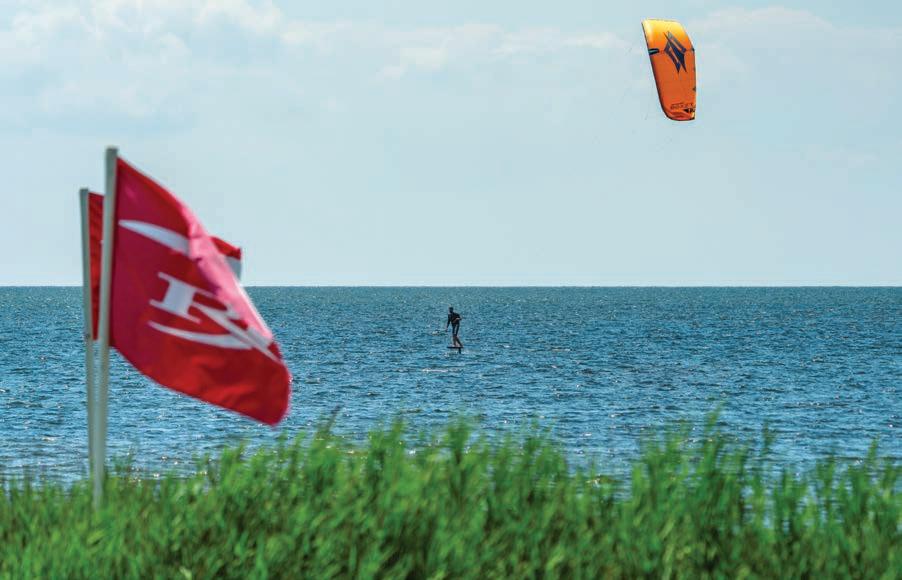
More than 20 years ago, Charlottean Clay Grubb discovered his love for kiteboarding. Over the last decade, he and friends have planned an annual visit to REAL Watersports on Hatteras Island in the Outer Banks to keep their skills fresh.
“Twenty years later and I’m still going strong,” says Grubb, CEO of Grubb Properties. “It’s a little bit of a steep learning curve because it’s all about flying the kite more than it is strength. It’s something you can do much later in life.”
On the ocean, a kitesurfer focuses on riding waves with their feet strapped to a board while holding a kite. Kiteboarding also harnesses the power of the wind to ride along the water, learning tricks on flatwater such as a bay or sound.
“You start with jumping, and then you work on back rolls, front rolls, double back rolls,” Grubb explains. “I’m probably not as aggressive as I used to be, but we continue to have fun and push everyone.”
The Outer Banks, known as the “Kite Boarding and Wind Surfing Capital of the East Coast,” offer kiteboarders and kitesurfers the Atlantic Ocean on one side and Pamlico Sound on the other.
Various companies offer private and group lessons to learn kiteboarding and kitesurfing. Kitty Hawk Kites offers a first-time course and three-hour private lessons. Kite Club Hatteras provides beginner, intermediate and advanced lessons to learn board and kite control, how to launch the kite, and gear selection. REAL Watersports runs Zero to Hero Kite Camp, a three-day experience with five hours of instruction each day, using a proprietary coaching method. A coach works with two students at a time.
“All of our sound-based activities are facilitated by our ‘On the Fly Coaching,’” says Jason Forrest, director of resort operations at REAL Watersports. “We’re the first ones to ever use Jet Skis to teach kiteboarding. No matter the wind direction from our facility, you can go out and find uncrowded terrain and good wind.”
After a day of jumping waves and flying across the ocean tethered to a kite, Edgecamp Pamlico Station offers nearby accommodations in Rodanthe on Hatteras Island. The 14-suite hotel debuted last summer and is accessible to local attractions, beaches and restaurants.
Pamlico Station’s bright orange doors welcome guests into

suites with a living room, dining area, fully equipped kitchen and bedroom. Evidence of designer Jonathan Adler’s “modern American glamour” is marked by the whimsical art, bold colors and personal touches throughout the space. Some suites have private patios with chair hammocks, an ideal place to unwind after a day on the water.
Guests can relax at the wellness center, an outdoor deck with a sauna, two cold plunge baths and a hot tub. Book an inroom massage or a beachside yoga session through the hotel’s concierge service. Arrange for your kitchen to be stocked or for a private chef to provide meals.
Attractions along the islands’ shores are a short trip from Rodanthe. Head north to Bodie Island to tour the Bodie Island Lighthouse, Jockey’s Ridge State Park and the Wright Brothers National Memorial. Wander along boardwalks, look for wildlife and learn about the area’s history at each of these parks.
Drive south to the tip of Hatteras, home to the Graveyard of the Atlantic. A museum designed to look like a ship highlights the history of the Outer Banks and the stories behind some of the 2,000
shipwrecks off the coast.
Schedule a guided tour through the Frisco Native American Museum & Natural History Center. The museum features thousands of artifacts from across the country and a special exhibit on the Croatan people who once lived on Hatteras Island. Nature trails lead visitors through several acres of a maritime forest and over a pond.
Cape Hatteras Lighthouse, a popular island attraction, is undergoing an 18-month restoration and is expected to reopen in summer 2026.
Roanoke Island, just east of Bodie, is home to Manteo, a charming town on the water. Walk to restaurants and shops, visit the Roanoke Island Festival Park and dine at the Lost Colony Tavern. A few minutes away by car is The Elizabethan Gardens, a 10-acre botanical garden with walking trails, sculptures and 500 varieties of plants.
Next door to the gardens is Fort Raleigh National Historic Site, a 355-acre attraction dedicated to telling stories dating back to 1580. The park hosts “The Lost Colony,” a production running since 1937 in an outdoor theater on the water. The performance details the unsolved mystery of England’s attempt to start a colony. SP
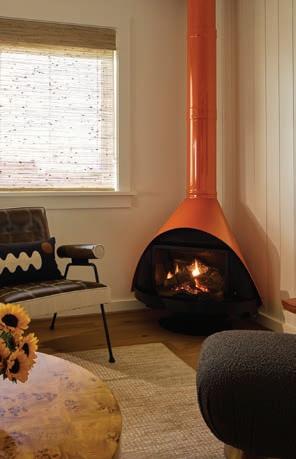


Families flock to Charleston’s beaches in the summer, meaning there are often thinner crowds in the city proper.
Stay close to shopping, restaurants and iconic attractions like Waterfront Park, the Pineapple Fountain and Rainbow Row at The Loutrel, a 50-room boutique hotel in the French Quarter. This casually elegant property feels simultaneously central to the action and pleasantly secluded.
Designed by Michael Graves Architecture and Design, the décor is traditional but comfortable, with a soothing palette of soft blues and greys. The bright and airy lobby is reminiscent of a breezy southern porch, with fresh florals, an oversized garden painting by Charleston artist Linda Fantuzzo — even a porch swing recalling lazy summer days.
Guest rooms are subdued-but-sophisticated for relaxing after a day on the town, with luxe touches like Matouk linens and Deep Steep (another local brand) bath items.
There’s a spacious second-floor clubroom — with a lending library provided by local bookseller Buxton Books — and a rooftop terrace just for hotel guests. Plan in advance to reserve “Lady
Loutrel’s” afternoon tea on the roof — with teas from Charleston’s Oliver Pluff & Co. and a tower of sweet and savory treats.
All the little extras are included here — from a hearty continental breakfast in the Veranda Lounge to “Charleston’s Finest Hour,” a cocktail hour held daily from 4-5 p.m. Gourmet snacks (benne wafers, cheese zingers, okra chips from Charleston’s Own) and nonalcoholic drinks in guest rooms and the clubroom are complimentary. Even the fitness center stocks fresh fruit and energy bars for a post-workout pick-me-up.
Kick off the evening with a pickle-brine martini or a cooling State Street Spritz (tequila, Italicus, green juice syrup and cucumber) in the Veranda Lounge before heading out to dinner.
Charleston’s culinary scene rarely disappoints, and one local hot spot is Costa, serving a seasonal menu of Mediterranean coastal cuisine incorporating lowcountry ingredients. Overlooking the Ashley River on the western tip of the Charleston peninsula, the large, bustling restaurant has a sleek mid-mod design with warm woods and subtle coastal accents. Start with caviar or a zesty hamachi crudo, followed by simple-but-flavorful Pecorino


ravioli. For the main course, there are familiar Italian favorites (Eggplant Parmigiana, Chicken Margherita) along with freshcaught seafood like a grilled swordfish with preserved lemon, capers and Sicilian olive oil. Don’t skip the housemade focaccia or dessert — the Almond Polenta Cake is a not-too-sweet, right-sized ending to your meal.
For upscale (but not too fancy) southern fare in a cozy tavern setting, Lowland has a tightly edited menu including crispy South Carolina quail and a bluefin tuna rice bowl. The Shells & Seafood Ragu (rock shrimp, lump crab and Parmesan) is comfort on a plate. While the city slows down as the calendar eases into summer, Charleston always buzzes with things to do. If you missed Charleston Wine + Food’s main spring event, the fun continues with the Summer Sizzle, a series of signature lunches and dinners, wine and bourbon tastings, bar takeovers, and more through July 31. The Spoleto performing-arts festival runs through June 8, culminating with an outdoor concert by indie rockers Yo La Tengo. On July 20, Jason Isbell and the 400 Unit play the Gaillard Center, which hosts the Lowcountry Jazz Festival Labor Day weekend. SP

Home chefs can hone their skills with a cooking class by some of Charleston’s top culinary professionals at The Restaurant at Zero George, adjacent to Zero George Hotel.
Housed in a two-story Federal-style house and several adjacent buildings, the 16-room hotel is one of Charleston’s most elegant stays, meticulously restored to maintain the historic home’s integrity while introducing a fresh, contemporary aesthetic. The cozy restaurant kitchen, with exposed brick and wood ceiling beams, has been a working kitchen since the home was built in 1804.
Demonstration-style classes are offered at lunchtime on Saturdays and Sundays and on Monday evenings, when the restaurant is closed. The classes are $235 per person and include a three-course meal with wine pairings led by Zero George’s culinary team. Dishes highlight what’s local and in-season. Sample summer plates: a chilled heirloom tomato gazpacho or Carolina shrimp with sweet corn and stone fruit. Space is limited to eight guests for an intimate, relaxed experience.


In Winston-Salem, a
by Ross Howell Jr. |
In a letter dated May 27, 1912, Katharine Reynolds details what she wants her estate’s conservatory to include — a palm room, a “good-sized” grapery, a tomato section, a large vegetable section, a propagating room and a “nice workroom.” When Lord and Burnham, the premier builder of glasshouses in America in the mid-19th and early 20th centuries, responded with their plans and perspectives — and their quote of $7,147 — Katharine wrote back that it was too much money. The greenhouse additions in the rendering were removed.
“In all her correspondence, you get a sense of how direct, handson and detail-oriented Katharine was,” says Bari Helms, director of the archives and library at Reynolda House Museum of American Art, which is part of Wake Forest University in Winston-Salem.
Katharine was, of course, the irresistible force behind Reynolda, completed in 1917. Backed by the tobacco empire of her husband, R.J., Katharine began to purchase tracts of land near Winston-Salem, eventually acquiring more than 1,000 acres, each parcel deeded in her name alone. Her idea was a progressive one — to create a self-
by Amy Freeman
sufficient estate that included a country house, a farm utilizing the latest in technology and agricultural practices, a dairy, recreational facilities, and a school.
The conservatory, located very near what is now Reynolda Village, was an integral part of Katharine’s design. October 2024 marked the end of a yearlong restoration of the structure, renamed the Brown Family Conservatory and Reynolda Welcome Center.
“Katherine wanted the estate to look and feel like an old English hamlet,” says Phil Archer, deputy director at Reynolda House Museum of American Art.
“[Contractor] Rough Brothers had access to actual Lord and Burnham plans and molds,” says Jon Roethling, the director of Reynolda’s gardens who oversaw the project. So, for the restoration, the company could use templates on hand, extruding aluminum pieces to match the originals.
“When I walk into the palm house now, the architecture just sings,” Roethling says.
End-to-end, the central structure of the conservatory and the
greenhouses flanking it extends more than 300 feet. Sod has been laid the entire length, creating a walking path for visitors. Between the edge of the sod and the foundations of the greenhouses are planting beds, about 8 feet wide, filled with peonies.
“The problem,” says Roethling, “is once the peonies bloomed out, that was pretty much it, visually. I needed someone who could do something amazing.” Roethling reached out to Jenks Farmer, a plantsman in Columbia, South Carolina, who created a design for the peony beds incorporating other perennials that bloom throughout the growing season.
In the conservatory proper, each bay has a different theme.
“This first bay is in the spirit of an orangerie, which represents the birth of greenhouses,” says Roethling. Much like the original 17th-century orangeries in England and throughout Europe, the bay also features olive trees and other fruiting plants, and will be used to illustrate a narrative history of the development of greenhouse structures over the centuries.
The next bay is an arid greenhouse, featuring the five Mediterranean climates of the world — Southern California, the Mediterranean Basin, South Australia, South Africa’s Cape area and central Chile.
The central palm house is elegant, with sealing wax palms with their deep red canes and tall Bismarck palms with their silver fronds, all in large containers. Visitors can compare the broad texture of a palm frond to, say, the fine texture of a fern. “There’s a lot of texture — greens, whites and silvers,” Roethling says.
The next greenhouse bay features bromeliads, orchids and other flora that thrive in the tropics. It’s all about color — abundant, dramatic color. “In here, I want to have freaky things that visitors walk up to and ask, ‘What is that?’” says Roethling with a broad smile.
The final bay serves as a holding house for resting orchids, organized by types, with interpretative signage. “Even though the orchids won’t be in bloom there,” Roethling says, “that greenhouse will still be beautiful and educational.”
Just as Katharine would have expected. SP

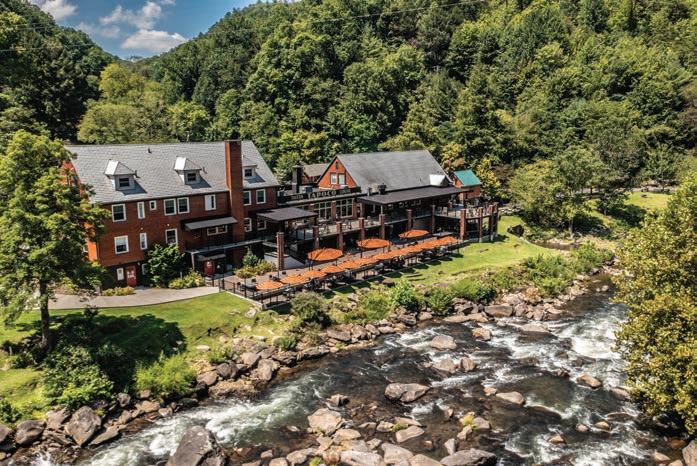
Graham County and Historic Tapoco Lodge offer a rustic respite for car enthusiasts and nature lovers by Cathy Martin
In early August, the kudzu creeps right up to the edge of Ronnie Milsap Highway, spilling over the guardrails and hugging the curves of this sparsely traveled road in Nantahala National Forest.
It’s peak summer, but there are no throngs of tourists in this remote corner of the state. If you’re looking to get away from it all, this might be the place.
On my left, the Cheoah River rushes — the highway and river lead to Tapoco Lodge, my home

The area is perhaps best known for the Tail of the Dragon, a harrowing 11-mile stretch of U.S. Route 129 with 318 curves — the starting point in Deals Gap is a short drive from Tapoco. On my second day at the lodge, I left for a morning hike and returned to find 17 Porsches in the parking lot, their drivers refueling at Tapoco Tavern. But it’s not just luxury cars — meetups for Miatas, Mustangs, Fiats — even Priuses — converge here to take a shot at “taming” the Dragon.
On the 2-mile Joyce Kilmer Memorial Forest Loop Trail, explore one of the largest stands of old-growth trees in the eastern United States — some more than 300 years old — and tulip poplars more than 100 feet tall. Yellow Creek Falls is a .7-mile out-and-back trail that leads to a 70-foot waterfall. The 2.2mile Huckleberry Knob Trail leads to a grassy summit with views of the Blue Ridge. The lodge’s on-site Bear Creek Falls Trail is ideal for a short stroll along the river; be cautious beyond the immediate area, as the path quickly turns rugged with roots and slick spots.
Lake Santeetlah might be the most pristine body of water in North Carolina. Boats and kayaks can be rented at Santeetlah Marina. At the larger Fontana Lake, rent fishing boats, canoes, kayaks or pontoon boats for exploring the lake’s 240 miles of shoreline.
Nantahala Outdoor Center is less than an hour from the lodge, with whitewater rafting, inflatable kayaks, mountain biking and ziplines.
for the next two nights. The rustic lodge was built in 1930 by the Tallasee Power Company as a retreat for executives overseeing nearby hydroelectric-power projects. (Fun fact: The lodge is two minutes from Cheoah Dam, where a thrilling scene from the 1993 Harrison Ford movie The Fugitive was filmed). Tapoco evolved as a tourist destination, adding cabins, a tennis court and a “tin can” theater that was used as a dance hall and community center that hosted going-away parties for local soldiers during WWII.
Stepping into the lobby feels like stepping back in time: country music plays, old framed photographs line the walls, and snacks, souvenirs, T-shirts and trinkets are for sale, giving the impression of an old-time country store.
There’s a cozy bar, the Laurel Lounge, off to one side and a dining room on the other. Outside at Tapoco Tavern, red-striped umbrellas stretch across a wide patio perched on the riverbank, where guests sip pints of beer and nosh on burgers, nachos and pizzas.
Tapoco, on the National Register of Historic Places, sits on 120 acres, with 11 lodge rooms, 18 cabin rooms, tennis and pickleball courts, and walking trails. The lodge isn’t fancy, but it’s quaint, immaculately maintained and staffed with friendly locals eager to share recommendations for things to do in the area.
I stayed in the third-floor Rhododendron suite (walk-up only — there are no elevators in this historic property), with wood-plank floors, a large sitting area and separate bedroom, and a spacious bathroom with retro honeycomb tile. Behind the lodge, cabins are spread out in a camp-like setting with split-rail fencing, moss-covered stone walls, a gentle stream and a tidy firepit area.
In the morning, there’s a self-service coffee station (regular or bourbon-pecan). Breakfast in the Cheoah Dining Room is a hearty affair: omelettes, glazed pecan French toast, pancakes and biscuits. Take your breakfast outside and listen to the sounds of the river as you plot the day’s activities. SP

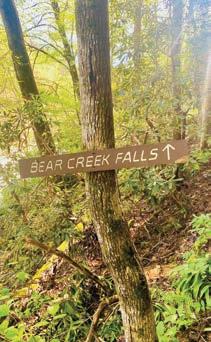




















Carolina Theatre
March 28
Legendary soprano Renee Fleming sang alongside the Charlotte Symphony Orchestra — a memorable night which doubled as the grand reopening of the newly renovated Carolina Theatre. photographs by Daniel Coston




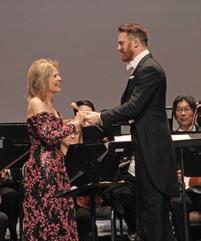

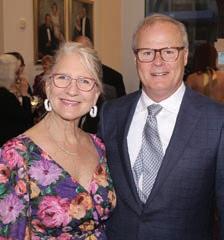







benefiting Levine Children’s Hospital Bank of America Stadium
March 29

The evening was capped off by a surprise appearance by DJ Questlove that kept patrons dancing far into the night. photographs by Daniel Coston
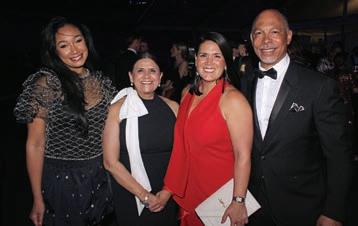



presented by Mint Museum Auxiliary Charlotte Country Club
April 9
Mary Celeste Beall, proprietor of Blackberry Farm, and Steele Marcoux, editor-in-chief of Veranda magazine, discussed luxury travel, art and design during the sold-out luncheon. photographs by Daniel Coston






benefiting Bechtler Museum of Modern Art
The Bechtler
April 4
This year’s bash brought the Big Top to the museum. Complete with circus tent, daredevil acts and a ringmaster, the night delivered big on nostalgia, whimsy and excitement. photographs by Daniel Coston


There’s more than meets the eye in Richard Hunt’s sculpture at Romare Bearden Park.
by Michael J. Solender
If you’re heading uptown for a Knights game, concert or fireworks this summer, pause for a moment to admire Richard Hunt’s soaring sculpture in Romare Bearden Park.
Nearly 30 feet tall and weighing four tons, this swirling tornado of stainless steel is the Chicago sculptor’s tribute to his longtime friend and fellow artist Romare Bearden.
Spiral Odyssey was commissioned by the Arts & Science Council and installed in 2017 at the southern end of Bearden Park — Charlotte’s own homage to its native son.
At the sculpture’s dedication, Hunt spoke of the symbolism in the piece and his deep respect for Bearden. “The ‘odyssey’ in the title, refers to Bearden’s series of works inspired by Homer’s epic poem,” he said. “It also speaks to Bearden’s personal journey.”
“Spiral” is a nod to the Spiral Group, a Black artists’ collective that Bearden co-founded in 1963. The group focused on supporting and advancing African American abstract art, a cause Hunt said he directly benefited from.
Hunt, who died in 2023, enjoyed a decades-long friendship with Bearden.

In 1971, the two held solo exhibitions concurrently at New York City’s Metropolitan Museum of Modern Art — the first contemporary African American artists to do so.
Designed to be appreciated from every angle, Spiral Odyssey incorporates an Archimedean spiral that radiates outward as it climbs, symbolizing the circular nature of progress. The base, shaped like a ship’s bow, suggests both forward momentum and the suffering endured
during the Middle Passage. Viewers may also spot abstract sea birds and ocean creatures playing among the skywardreaching waves of reflective steel.
“Sometimes it is not about making art,” Hunt said, referencing his body of work. “Sometimes it is about making statements about culture and history — or history and culture — through art.”
Spiral Odyssey seems to suggest to viewers: Dream big, then soar to achieve those dreams. SP





